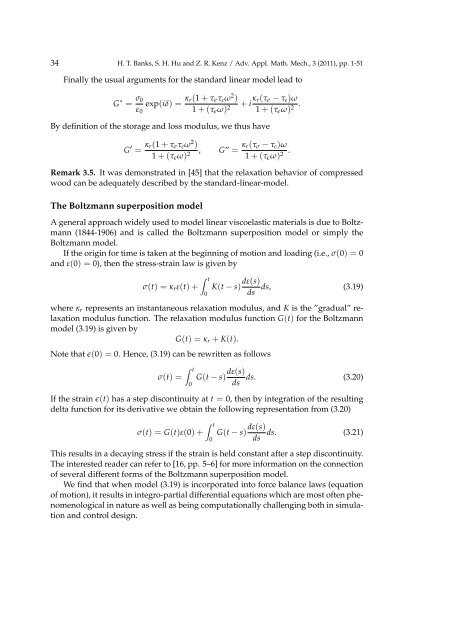A Brief Review of Elasticity and Viscoelasticity for Solids 1 Introduction
A Brief Review of Elasticity and Viscoelasticity for Solids 1 Introduction
A Brief Review of Elasticity and Viscoelasticity for Solids 1 Introduction
You also want an ePaper? Increase the reach of your titles
YUMPU automatically turns print PDFs into web optimized ePapers that Google loves.
34 H. T. Banks, S. H. Hu <strong>and</strong> Z. R. Kenz / Adv. Appl. Math. Mech., 3 (2011), pp. 1-51<br />
Finally the usual arguments <strong>for</strong> the st<strong>and</strong>ard linear model lead to<br />
G ∗ = σ 0<br />
ε 0<br />
exp(iδ) = κ r(1 + τ σ τ ε ω 2 )<br />
1 + (τ ϵ ω) 2 + i κ r(τ σ − τ ε )ω<br />
1 + (τ ϵ ω) 2 .<br />
By definition <strong>of</strong> the storage <strong>and</strong> loss modulus, we thus have<br />
G ′ = κ r(1 + τ σ τ ε ω 2 )<br />
1 + (τ ϵ ω) 2 , G” = κ r(τ σ − τ ε )ω<br />
1 + (τ ϵ ω) 2 .<br />
Remark 3.5. It was demonstrated in [45] that the relaxation behavior <strong>of</strong> compressed<br />
wood can be adequately described by the st<strong>and</strong>ard-linear-model.<br />
The Boltzmann superposition model<br />
A general approach widely used to model linear viscoelastic materials is due to Boltzmann<br />
(1844-1906) <strong>and</strong> is called the Boltzmann superposition model or simply the<br />
Boltzmann model.<br />
If the origin <strong>for</strong> time is taken at the beginning <strong>of</strong> motion <strong>and</strong> loading (i.e., σ(0) = 0<br />
<strong>and</strong> ε(0) = 0), then the stress-strain law is given by<br />
∫ t<br />
σ(t) = κ r ε(t) +<br />
0<br />
K(t − s) dε(s) ds, (3.19)<br />
ds<br />
where κ r represents an instantaneous relaxation modulus, <strong>and</strong> K is the ”gradual” relaxation<br />
modulus function. The relaxation modulus function G(t) <strong>for</strong> the Boltzmann<br />
model (3.19) is given by<br />
G(t) = κ r + K(t).<br />
Note that ϵ(0) = 0. Hence, (3.19) can be rewritten as follows<br />
σ(t) =<br />
∫ t<br />
0<br />
G(t − s) dε(s) ds. (3.20)<br />
ds<br />
If the strain ϵ(t) has a step discontinuity at t = 0, then by integration <strong>of</strong> the resulting<br />
delta function <strong>for</strong> its derivative we obtain the following representation from (3.20)<br />
∫ t<br />
σ(t) = G(t)ε(0) +<br />
0<br />
G(t − s) dε(s) ds. (3.21)<br />
ds<br />
This results in a decaying stress if the strain is held constant after a step discontinuity.<br />
The interested reader can refer to [16, pp. 5–6] <strong>for</strong> more in<strong>for</strong>mation on the connection<br />
<strong>of</strong> several different <strong>for</strong>ms <strong>of</strong> the Boltzmann superposition model.<br />
We find that when model (3.19) is incorporated into <strong>for</strong>ce balance laws (equation<br />
<strong>of</strong> motion), it results in integro-partial differential equations which are most <strong>of</strong>ten phenomenological<br />
in nature as well as being computationally challenging both in simulation<br />
<strong>and</strong> control design.

















